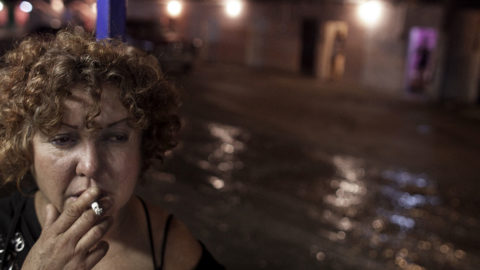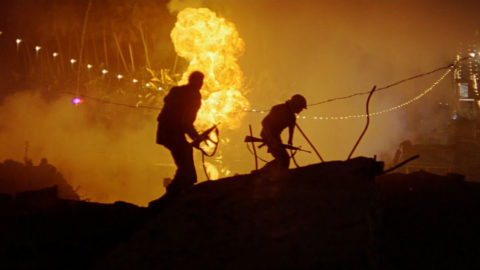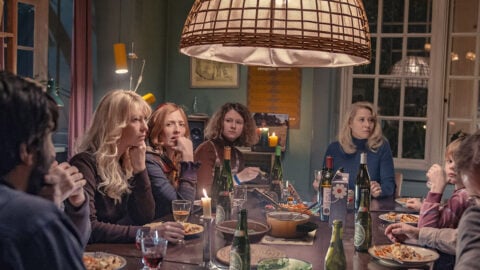Interview: Anthony Dod Mantle
This interview is part of a series with influential cinematographers who attended the 2016 Camerimage International Film Festival of the Art of Cinematography in Bydgoszcz, Poland, in November.
Copenhagen-based Anthony Dod Mantle burst onto the cinema scene in the late ’90s with his frantic, transgressive handheld camerawork in Thomas Vinterberg’s The Celebration (1998), the inaugural film of the subversive Dogme 95 movement. In accordance with Dogme’s rejection of control and its embrace of spontaneity, Dod Mantle wields the camera like a hunter in The Celebration, observing and physically emulating the emotional dynamics of the dysfunctional family at the center of the film. This obsession with conveying psychology through formal elements runs through Dod Mantle’s body of work, from his gloomy, intensely expressionistic rendition of grief, eroticism, and madness in Lars von Trier’s Antichrist (2009), to his subtly disquieting representation of political paranoia and anxiety in Snowden (2016), Oliver Stone’s account of the controversial American computer specialist’s rise to prominence via his leaking to the public of the NSA’s illegal surveillance tactics. Dod Mantle’s vigorous, intuitive camerawork in Danny Boyle’s Mumbai-set Slumdog Millionaire (2008) is reminiscent of his collaborations with Vinterberg and von Trier through its reliance on light, unobtrusive digital technology and its passionate immediacy.
Film Comment spoke with Dod Mantle about handheld camerawork’s relationship to dance and cinematographers’ need for constant self-reinvention, at the 2016 Camerimage Film Festival where he won the Bronze Frog award for his work on Snowden.
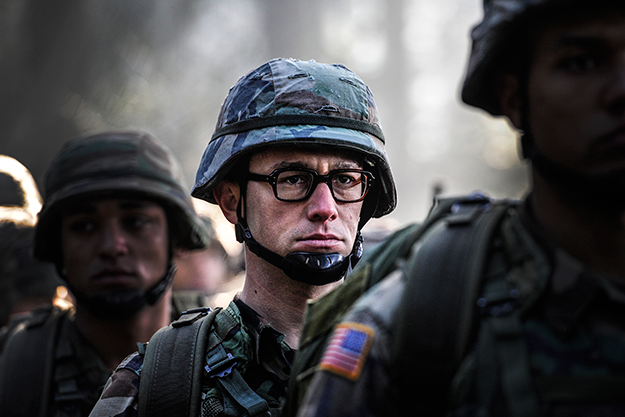
Snowden
The driving idea behind Snowden was to infuse the cinematography with a feeling of voyeurism, a formal expression of the film’s themes of surveillance and paranoia. Interestingly, this was also the crux of your approach on The Celebration, in which the camera is a kind of intrusive, aggressive witness, a living embodiment of fractured family bonds.
I never thought about that, that’s really funny. Actually, I was saying to somebody else recently about Snowden, thinking about the way I sometimes place the camera in a scene with two people talking: there’s a shot from this angle and one from the reverse, but there’s also a third presence or a third listener. On The Celebration, I had to tell all the actors that there were two worlds: the earth, where the drama and the narrative of the conflict took place, and then this whole other side, the dead sister’s world—not just her world, but the sister as a person, whatever is mentally left in our heads which has space for, not the supernatural, but the other, unworldly…
The metaphysical dimension.
Yes, the metaphysical, which is a world that I love so much and which has kept me alive until now, my instinct and my poetry as a filmmaker. What you mentioned is maybe latent in me, because I make a lot of films and I’ve made quite a few since The Celebration. And each time a new story comes, it is officially a new dialogue with a new person and with myself about what the alphabet should be for that given film. I probably do repeat myself or revisit some unfinished elements in what I think. So it’s very clever what you said, but it’s also logically and simply what happens: I revisit certain ideas about why I place or move the camera in a certain way, and that is a clear parallel.
Oliver [Stone], in his own simple and industrial way as a storyteller, is quite banal and direct in his filmmaking ideas, certainly more so now than when he made films like JFK or Natural Born Killers. Maybe he was younger then, and he certainly had a very strong rapport with Robert Richardson, the DP of a lot of his early films. Honestly I don’t know if we’ve succeeded [in Snowden]… It’s been a difficult film because it is a lot about people talking, a lot of information. Right now I’m looking at you and I can make up my mind very quickly about whether I believe you or not, and I can make sense of you on a more meta level. So the difference between that and the whole cyber world we live in today—social networks and cameras and what I do as well—is very important, and it’s very essential to the main concern of Snowden. We live in a world where there is less privacy. The ethics are changing, and people who administer certain things, including me placing a camera without telling the actor there’s one up there, are… not dangerous, because you are doing something creative when you’re making a film. But if you’re sort of visiting people at night when they’re asleep and checking their computers or their phones, it’s a whole other story.
That’s the only real link with The Celebration camera-wise, and in both films I place cameras at high and low angles. I started to talk to Oliver about this, and I don’t know if you’ve noticed, but I’m actually quite rambly and poetic and sort of in and out of logic, so Oliver sometimes had trouble understanding verbally what I was precisely trying to say in a given situation. And I would usually end up saying, “Okay, this is not going to work. I need to show you.” So I showed him a panel of hundreds of fucking abstract pictures that helped him understand what I was trying to say and helped the film be more than just a talky talky.
It’s probably the most theatrical script you’ve ever worked with.
Yes, it’s like a cold case without a body, without a verdict, without a car chase or a sex scene. And because of the perfectionism of Oliver, who wants to produce the facts as best as he can for the audience, it takes quite a lot of time for the film to build up. So there’s only so much time left in the end to actually show the audience where Ed [Snowden] is now. But Oliver would argue, as the extraordinary method-driven monster that he is—he’s a mixture of a wacky guy who smokes dope and a perfectionist with this incredible, almost autistic attention to detail—that people would just point a finger. And so he wanted to try and get as much as he could in there, because he knew that the studios were going to hit him anywhere. So he needed quite a large amount of factual material throughout the film, and it’s a lot about two shots and going back and forth between characters speaking.
And I really felt it was important as an artist to inject a little bit of audience space in there so there’s almost something else going on, and people are following not just the linear, intellectual, cerebral plot of the film, but are titillated by occasional staggered injections of something else. I wanted those injections to be subtle and restrained. I’m pretty vulgar and direct when I do colors, but Oliver himself is quite restrained. So I was having all these thoughts during my prep period, which was very short, but Oliver wasn’t there very much, he was still trying to get financial support for the film right up to about a week or two before we started shooting. So I was in Germany, where we shot the film, setting up these figures and the sets with the designers, and we were trying to work out the balance of what could be the credible reality, and what could, in a film language, be a little bit more spicy.
What about when you’re working with such a visually minded director as Lars von Trier? While I have you here, I can’t resist asking about the opening of Antichrist, which I find to be one of the most visually stunning and haunting opening sequences in the history of cinema. It’s just a mesmerizing articulation of the links between cinema and ballet. How was that scene designed? Did it involve a lot of storyboarding?
Antichrist, as you know, is the last film I made with Lars. He had a clear idea about what he wanted to do in that scene. We talked to and fro about black and white, and when we went into the pictures, it wasn’t a storyboard but more of an idea, a concept. And then we noticed that we needed to get more specific. Because it was high-speed and quite complex and there were children: you have to storyboard those kinds of scenes because you have to know in advance how you can do it.
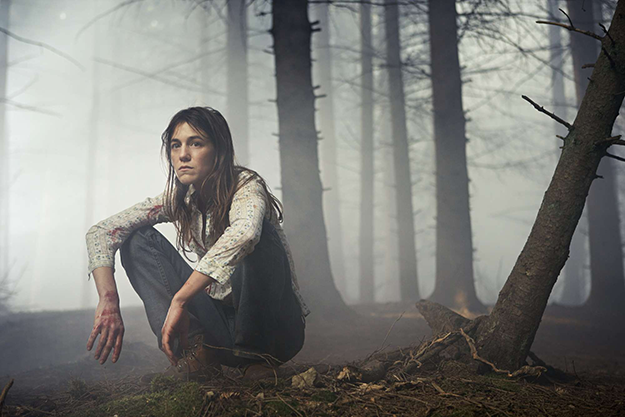
Antichrist
There is a definite logic behind the architecture of that scene, an exponential progression in the way images follow each other. I imagine the sex must have been carefully choreographed as well to achieve that balletic motion and allow for such microscopic acuteness in the camerawork.
Yes, so we had to do screenings on that so that the image of mom and dad fucking becomes a traumatic one—we’ve all been there. [Laughs] We still had a good creative relationship there with Lars and we always had a very good creative relationship on Antichrist regarding the more abstract stuff. If we had a conflict, it was actually more about naturalism and how to achieve it. I think that film is a fast and great meeting of our two different personalities and natures. We had a long time together, and Antichrist has become a kind of glorious thing. When it’s glorious, it’s really glorious—it’s like a work of art, with its good and bad sides. What happens when you’re in a good place with a director like that, you have him and he’ll listen and I could draw things as well, and we had some initial ideas and he developed them. Lars was very involved in the postproduction of that film because he knew that high-speed is quite technical. And you know, I came in and discussed why high-speed here and there, and how graphic the sex should be. And actually image number 3 in the film is like a pornographic shot—two big balls banging into the vagina. But it’s kind of beautiful.
Yes, it has a very dancerly feel. The camera has the power to magnify those kinds of bodily micro-movements.
Yeah. We worked with professional porn-star doubles, and it was very strange for me to be as close to a cock. I had never done that kind of stuff before.
Were you giving the performers technical instructions?
Yeah, “If you could just go in and out faster here, or maybe pull out there” [Laughter]
That’s so absurd.
It was so surreal. And then it becomes this kind of work of art. Immediately there’s flying bollocks in shot number 3 and it’s kind of astonishing. I looked at the raw material for a long time, not as a pervert, but just watching these balls swinging back and forth. And I was thinking: “This is fucking higher than stuff I’ve done before.” And it’s like the essence of our evolution with Lars. It was deeply extraordinary to me. It’s not my favorite image in there, but it is definitely special.
Speaking of dance, I am reminded of your camerawork in Slumdog Millionaire, which is your most intensely physical. As a camera operator, you like to position yourself right at the heart of the action, and you literally become a living camera in that film when you’re roaming through the slums like a boar. How does one prepare for such a physically engrossing shoot? Did you take dance lessons?
I’m actually the world’s worst dancer. I dance with the camera and with Chris Doyle, who’s also here, we often talk about dance and dancing with the camera. But he is a dancer. I’m kind of shy, like a cricket. But the way Slumdog works is a bit like The Celebration as well: I became a protagonist with the camera. In The Celebration, I was kind of a nervous member of the family who just couldn’t quite believe what was going on. You know, the shots were not evenly placed and the camera peered around to see: “Was that my aunt who said something?” and that kind of thing. So it was a protagonist-camera and not repetitive, but original, impulsive and spontaneous.
In Slumdog, because the kids couldn’t understand what I was saying and I didn’t understand what they were saying, I just had to find a way to move with these high-end, powerful cameras, and invent systems and stuff like that. I’ve always done that, so it wasn’t new for me—it was new for the world. But it helped me to get down in the area of children, not looking down at them but being with them. I was cutting a lot of scenes in my head—you just know in those situations: “That can work. If you do that, you will have to cut and reset.” I spent so much time on that film with people I couldn’t understand. We’d hear the interpreters whisper things, but we didn’t really know what was going on, we were just running around, sweating—me and a fantastic focus puller and Danny [Boyle] near me, just working with these kids.
I think the magic to Slumdog is about racing and running… I always have to give myself a recipe, a cooking pot, an idea, and follow that so it doesn’t become boring or militant, but an organic thing, the way I think. Snowden was a hard film for me to do because it was our first time working together with Oliver. We trust each other, we’re good together, but he’s also very, very traditional in some ways. I had to transcend that, and that’s what I tried to do.
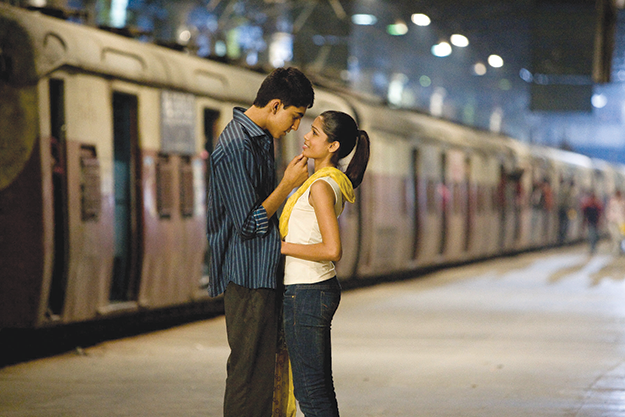
Slumdog Millionaire
Since your approach to cinematography is somewhat epitomized by your shooting style and the way you handle the camera, this kind of unplanned, kinetic experience as you’ve described it, I’m curious to know your reaction to von Trier operating the camera himself when you were working together. Did you ever feel like that inhibited your authorship as the cinematographer of his films?
No. You know, Lars has since then been working with Manuel Alberto Claro, and I think he’s better than me now because he does exactly what Lars wants. And I don’t want to do what a director doesn’t want, but I have a dialogue, a powerful emotional involvement, and directors either like that and choose you for that, or they don’t. And for a long time Lars and I had that relationship and it was great. And it lasted as long as it lasted. Towards the end of Antichrist, when he was getting very shaky and ill, he was losing even the ability to shoot a stabilized image. So every time he wanted to do a shot, I would come and say: “I don’t want to humiliate you. I want you to know I’m your friend,” and I would help him. In one of the early scenes, when they’re walking up the slope in the forest and there’s rain…
He shot that himself?
He did some of it, yes, and I helped him. But you know, it becomes on a cinema screen quite a bit disturbing, not necessarily good.
The image then becomes a direct translation of its creator’s inner turmoil, the way a poet’s verses may be the outpouring of his soul.
But that’s sad… We had conversations about that, and the bottom line is that it became a very difficult place for me to be in. And I was very close friends with him and we were very close allies, so it was hard for me to say this and do these things. I never wanted to hurt him and I never did, but I think it was hard for him.
So you almost acted like a life coach to him on set.
I was his friend and ally. You know, when I first went to Denmark and built myself a life there, there were a few lights, a few strong candles, and he was one of them. I very rarely approach people because I’m shy, but I approached him and we became friends, and I was very close to him for a long time. And it was a very privileged place to be in. We taught each other a lot.
Working with him must have shaped your relationship with images.
Yes, it has informed it a lot. And I’ll always remember and thank him for that. He’s done things that were less noble and honest, and that’s his own shit and fight. It doesn’t have anything to do with the filmmaking, it’s just him—you have to separate that.
He is a troubled poet, but one can also argue that the beauty of his work comes from the bruises of his soul.
Yeah, a lot of poets are troubled. I’ve always had this philosophy that the good poets, like Doctor Zhivago, can get through it all when all the soldiers and politicians are killed. The poets are there to clear the mantel and carry their boots and get through. I think that’s why people who truly love cinema survive. That’s why when I judge films here [at Camerimage] for instance, I try to commend poetry—that’s what’s important. Everything else is known.
Yonca Talu is a filmmaker living in New York. She grew up in Istanbul and recently graduated from NYU Tisch.



